A History Of PCHS/PCSS
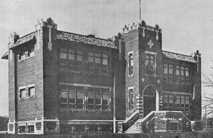
In the early years of this century, high school was available only in Toronto, and students who lived in Port Credit had to travel all the way to Parkdale Collegiate, if they wanted to continue their schooling beyond Grade 8. Shortly after World War I, overcrowding become a concern. There was a movement in city schools to raise the fees of students living outside the district, or even to exclude them from attending altogether.
At a public meeting, Port Credit rate-payers reacted by agreeing to construct a 5-room school on 3 acres of land to be shared by elementary and secondary students. By 1919, the Port Credit Public School Board establishes its "Continuation School" on Forest Avenue (pictured at left). It consisted of 2 rooms and boasted 2 teachers: Mr. H. A. Doupe and Miss Leggott. All 22 students paid tuition fees! Although "First Form" was free, "Second Form" costs $9.00, while "Third and Fourth Forms" set students back $15.00 a year.
The need for more space was soon apparent. In fact, because the school did not have an auditorium, drama students performed the 1922 production of A Midsummer Night's Dream at Clarke Hall. Lack of proper facilities also limited physical education classes. Basketball has to be played outside, weather permitting. Even baseball suffered, with games played on grounds that resemble a farmer's ploughed field. In 1926, a six-room addition was added to accommodate ever-rising numbers. By 1928, the school growth jumps exponentially; there are 217 eager students and a dedicated staff of six!
A Brand New School
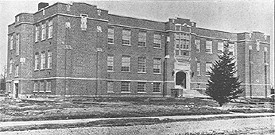
In June of 1929, on the eve of the Great Depression, excavation began on a new building for Port Credit High School. It was to consist of ten classrooms, physics and chemistry labs, a library and an auditorium which seated 500. Add to these features, a brand new gym, a circular track, a basement cafeteria (with separate boys' and girls' lunch rooms), a "Lady Teachers' Room", and individual lockers for winter wear. There you have it --- all you can desire in a modern high school!
The 1930s - Facts And Figures
Port Credit High School enters the Great Depression with a student population of 283 and nine teachers on staff. Kids stay in school and numbers continue to rise. By the end of the decade there are over 400 students pursuing academics. Outside the classrooms, students busy themselves with activities including the Glee Club, Dramatic Society and the six-Piece Orchestra.
Making its debut in 1930, Port Credit's Rugby Team competes in the "Lakeshore League" against Etobicoke, Mimico, Long Branch and Islington High Schools. All players must provide their own equipment; the Boys' Athletic Association supplies the sweaters and the Board of Education tosses in the balls. Girls' softball continues to be popular, but competes for fans with basketball, hockey and track and field. The 1938 season marks Credit's first entry into the Toronto District Interscholastic Athletic Association competition. Mr. Wilf Wood takes up the challenge and coaches the "Gym Team" to various city championships.
The 1940s - Facts And Figures
The coming of World War II is understandably accompanied by a sharp decline in enrollment at Port Credit High School. The student population falls as low as 200. Some march off to enlist; some join the war effort on the home front; still others are needed by their families. Extra-curriculars reflect the times. Both Boys' and Girls' Cadet Corps and the Boys' Bugle Band become prominent features on the playing field.
By the end of the war, as prosperity returns, Port Credit's numbers are once again on the rise. There are more than 500 students and over 20 teachers by 1947. But not everyone who left returns; 26 people, including students and teachers, lose their lives in active service.
Among the changes during the decade is the introduction of Vocational Guidance as a regular part of the program. Music certainly becomes more diverse with the addition of a "Hillbilly Band", and singing proves more popular than ever when 160 voices join Mr. Lankin's choir. The student newspaper is now called The High Light and, as a result of a school-wide contest, P.C.H.S. has its own song. New extra-curriculars include "Clubteen" and the Leadership Club, both introduced in 1948.
On the playing fields and in the gyms, Mr. Nick Volpe and Mr. Frank Munro coach Port Credit to its share of victories, including championships in Girls' and Boys' Basketball, Rugby and Tumbling.
The 1950s - Facts And Figures
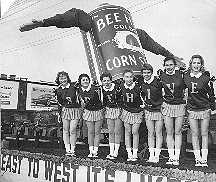
Port Credit ushers in the fifties with 675 students and 23 teachers, but change is inevitable. By the middle of the decade the school population nearly doubles and Port Credit High quickly expands under a new name: Port Credit Secondary School. The creation of new schools like Graydon and Lome Park helps by diffusing students across the growing region. Nevertheless, Port Credit needs a new wing to accommodate ever-growing numbers. The addition includes home economics rooms, shops, a real art room and a second gym. Boys get the new one; girls must occupy the old one.
Students occupy themselves with the 10-cent basketball games, weekly assemblies, magazine fund-raisers, and spot, tag, conga and "Paul Jones" dances. What seem to matter most, however, are the changes in the cafeteria. Lunch period is extended to 50 minutes and traditional taboo forbidding boys and girls to eat at the same table is finally lifted.
The Fire
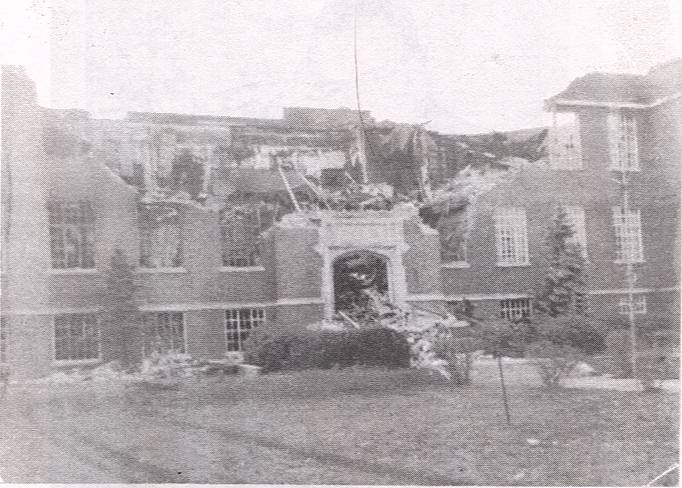
The most drastic change comes on October 18, 1956 when fire engulfs the halls of the school. awakened by a barking dog, Mrs. Kay Lucas, a nearby resident, notices the flames at 4:15 a.m. Her son, Bert, turns in the alarm. Although the hands of the school clock are stopped at 3:09 a.m., firefighters set the start of the blaze at least one hour earlier. Damage is incredible, as fire quickly destroys the auditorium, the main office, the guidance rooms and the science labs. More than 100 firemen from Port Credit, Cooksville, Lakeview and New Toronto struggle for 8 hours to bring the flames under control.
When it's all over , eleven classrooms are ruined, including all the commercial rooms. The old wing is completely gutted and the new wing suffers smoke and water damage. All current records are lost, along with textbooks and other personal belongings kept in lockers. The library, too, is waterlogged and many books have to be thrown away. The cost of damage is estimated at over $500,000.
But the Port Credit spirit cannot be diminished by the flames! As firefighters are still pouring water on smouldering ruins, scores of students, armed with mops and pails, move in to clean up the parts of the school untouched by fire.
The following Monday, students return to class with a few changes in their timetables. In order to house students until portables arrive, the schedule needs to be flexible. Grade 9's attend school on Mondays, Wednesdays and Fridays. Commercial students find space off school property at St. Andrew's Presbyterian Church and Trinity Anglican Church.
In a little over a month, things once again approach normal, as students return to the old 5-day-a-week timetable in new portables. Rebuilding is swift and by the spring of 1957 P.C.S.S. has a new face, both inside and out. With renovations, the building is large enough to accommodate 700 students.
On the last day of school in June 1957, the closing bell rings. Standing strong within the community, the school has survived nearly a decade of ongoing change. Well, almost. As 700 students stand attentively beside their desks, waiting for the majestic strains of "God Save the Queen", "Hound Dog" makes its raucous debut over the school speakers. Yes, it's Elvis Presley on the P.A.!
A New School Opens On Mineola
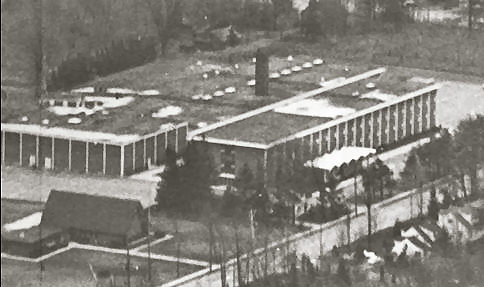
A new PCSS on Mineola Road East opens on May 13, 1963, with students walking up Hurontario from Forest Avenue in time to write their final exams. This move takes place with very little disturbance. Classes are dismissed an hour or so earlier than usual, enabling students to assist teachers with clearing files and packing up. The following morning, it's business as usual in the colourful new building.
The expansion of Port Credit to the present 3-storey building means a tripling of the student body and diversity in the school curriculum. The new shop wing offers a rich choice of options including electricity, drafting, auto mechanics, sheet metal, welding, woodworking, building construction and machine shop. The Music Department adds new instrumental courses to its solid vocal program. Complete with a weight room, huge gyms provide a venue large enough to cram in the whole student body for pep rallies. Brand new electric typewriters and calculators creep from room to room along the commercial corridor. Port Credit's 700 seat auditorium is the only large hall in south Peel and for only a dollar students and the public can enjoy the Drama Society's yearly play. With 8 periods a day, 3 lunch hours are necessary to accommodate students' timetables. Kids love to congregate in the cafeteria, where the daily "hot plate special" sets them back 35 cents.
The core of the student body still comes from the town of Port Credit, even though the boundaries now reach the QEW. Craigie Orchards, the site of trees not townhouses, proves tempting to apple swipers during football games, so much so that Mr. Craigie himself becomes a familiar face in the front office after many a game. The Warriors have their ups and downs, but it is a rare year that at least one of the teams fails to make the finals. School spirit is directed by the Harry Flood Fan Club from its offices on the fourth floor! On occasion, the voice of Harry himself foretells of some shattering school event over the P.A. airwaves.
Although the sixties will come to be known as the hippie era, the dress code at Port Credit remains conservative. Girls still have to wear skirts or dresses. Jeans are frowned upon, and shorts are strictly forbidden- most of the time. The heat wave during the 1966 departmental exams puts an end to that!